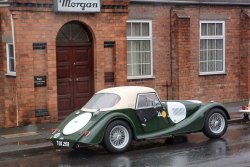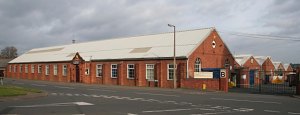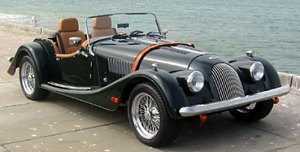
| - |


2018 production: 750 cars
2012 production: 1170 cars
2011 production: 900 cars
2010 production: 740 cars
2009 production: 690 cars
2007 production: 640 cars
2005 production: 584 cars
Since he took over the family business in 2006, Charles Morgan modernized the technology of its cars (thanks to BMW components) but kept their traditional looks and hand-crafted production method mostly unchanged. While other British sports car specialists went burst one by one, Morgan enjoys increasing sales and the longest waiting list (in terms of delivery time) in the auto industry.
As 3-wheelers became decreasingly popular over time, Morgan finally introduced its first 4-wheel car in 1936. It was called 4/4, which meant 4 wheels and 4 cylinders. The lightweight Morgan sports car offered good performance for its time. It chassis was made of ash wood frames sandwiched with thin aluminum skins, a lightweight feature still being used by its cars today.
In 1950, the 4/4 was succeeded by Plus 4, whose name implied an enlarged 4-cylinder engine, but it kept the classical pre-war sports car style. Morgan never built its own engines. Instead, it sourced engines from Standard, Conventry Climax, Triumph, Rover and Ford.
 Morgan Plus 8
Morgan Plus 81968 came the Rover V8-powered Plus 8. This engine, initially displaced 3.5 liters and later on 3.9 and 4.0 liters, provided sparkling performance to the lightweight Morgan. It served the car until as late as 2004 when Rover ceased its production.
Without any ambitious business plans, Morgan has always been satisified to produce cars by hands and in small volume. However, its Plus 4 and Plus 8 became increasingly outdated in chassis technology as the basics had not been changed since 1950. Entering the new millenium, the third-generation owner, Charles Morgan, started making changes. Not only the production facilities were modernized, he introduced an all-new model called Aero 8. This car employed an advanced aluminum tub chassis while preserving traditional ash wood frames in non-stressed area to please its customers. Its proportion and style also resembled the classic Morgan as far as possible, although aerodynamic was enhanced. BMW offered its V8 engines, transmissions and modern electronics, which helped it pass type approval tests in EU and USA. With Aero 8, Morgan was one of the few British sports car specialists improving its business in the first decade of new millenium.
In 2013, Charles Morgan lost the battle in the family power game and was ousted from the company. As a result, Morgan's products remained largely unchanged in the next few years. The V8 engine ended in 2018. By the next year, the Morgan family sold its majority stakes to Italian venture capitalist Investindustrial, ending its 110 years of history as a family business.